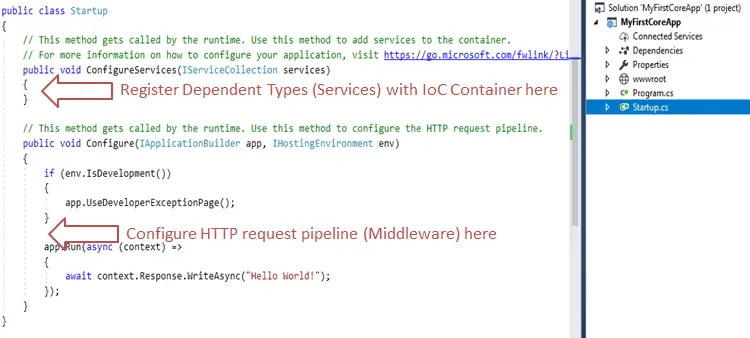ASP.NET Core - Startup Class
ASP.NET Core application must include Startup class. It is like Global.asax in the traditional .NET application. As the name suggests, it is executed first when the application starts.The startup class can be configured using
UseStartup<T>() method at the time of configuring the host in the Main() method of Program class as shown below.public class Program
{
public static void Main(string[] args)
{
BuildWebHost(args).Run();
}
public static IWebHost BuildWebHost(string[] args)
{
WebHost.CreateDefaultBuilder(args)
.UseStartup<Startup>()
.Build();
}
}
Open Startup class in Visual Studio by clicking on the Startup.cs in the solution explorer. The following is a default Startup class in ASP.NET Core 2.x.

Startup class includes two public methods: ConfigureServices and Configure.
ConfigureServices():
The Dependency Injection pattern is used heavely in ASP.NET Core architecture. It includes built-in IoC container to provide dependent objects using constructors.
The ConfigureServices method is a place where you can register your dependent classes with the built-in IoC container. After registering dependent class, it can be used anywhere in the application.
Configure():
The Configure method is a place where you can configure application request pipeline for your application using IApplicationBuilder instance that is provided by the built-in IoC container.
The following is a default Configure method.
public void Configure(IApplicationBuilder app, IHostingEnvironment env)
{
if (env.IsDevelopment())
{
app.UseDeveloperExceptionPage();
}
app.Run(async (context) =>
{
await context.Response.WriteAsync("Hello World!");
});
}
At run time, the ConfigureServices method is called before the Configure method.
No comments:
Post a Comment